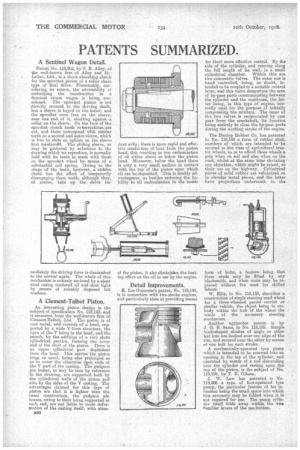PATENTS SUMMARIZED.
Page 22

If you've noticed an error in this article please click here to report it so we can fix it.
A Sentinel Wagon Detail.
Patent No. 118,202, by S. E. Alley, of the well-known firm of Alley and McLellan, Ltd., is a shock-absorbing clutch for the sprocket pinion of a roller chain type of final drive. Presumably, considering its source, the advisability of embodying the construction in a Sentinel steam wagon is being eonsiderpd. The sprocket pinion is not directly secured to the driving shaft, but a aleve is keyed to the latter, and the sprocket runs free on the sleeve, near one end of it, abating against a collar on the sleeve. On the face of the sprocket clutch teeth oriserrationsi are cut, and these correspond 'with similar teeth on a second and outer sleeve, which is free to slide on splines on the sleeve first .mention. The sliding sleeve, as may be gathered by reference to the drawing which we reproduce, is normally held with its teeth m mesh with those on the sprocket wheel by. means of a substantial coil spring. Owing to the shape of the teeth, however, a sudden shock has the effect of temporarily disengaging these teeth, although they, of course, take up the drive im mediately the driving force is diminished to the normal again. The whole of this mechanism is entirely enclosed by a sheet steel casing rendered oil and dust tight by means of suitably disposed felt, washers.
A Clement-Talbot Piston.
An interesting piston design is the subject of specification No. 118,142, and it emanates from the well-known firm of Clement-Talbot, Ltd. The piston is of cast metal, and consists of a head, supported by a wide V-form structure, the apex of the V being in the head, and the mouth, by the adrlitign of a very shdrt _cylindrical portion, forming the lower end of the skirt of the piston. There is an upper cylindrical part dependent from the head. This carries the piston rings as usual, being also prolonged so as to cover the otherwise even ends of the V part of the casting. The gudgeon pin bosses, as may be seen by reference to the drawing, are supported both by the cylindrical walls of the piston and also by the sides of the V casting. The advantages claimed for this type of piston are that it is lighter than the usual construction, the gudgeon pin bosses, owing to their being supportedat each end, are net liable to cause deformation of the casting itself, with atten
/350 dant evils; there is more rapid and effec tire conduction of heat from the piston head, this resulting in less carbonization of oil either above or below the piston heed. Moreover, below the head there is only' a very small surface M contact with the top of the piston upon which oil can be deposited. This is doubly advantageous, as besides reducing the liability to oil carbonization in the inside of the piston, it also diminishes the heating effect on the oil in use by the engine.
Detail ImDrovements.
K. Lee Guinness's patent, No, 118,144, is in connection with two-stroke engines, and particularly ainis at providing means for their more effective control. By the side of the cylinder, and running along the full length of its wall, is a small cylindrical chamber. Within this are two concentric naives. The outer one is hand controlled, being, no doubt, intended to be coupled to a suitable control lever, and this valve determines the area of by-pass ports communicating between the cylinder and the crankcase, the latter being, in this type of engine, 'normally used for the purpose of initially compressing the mixture. The inner of the two valves is reciprocated by cans gear from the crankshaft, its function being entirely to close the by-pass ports during the working stroke of the engine.
The Dunlop Rubber ars has patented in No. 118,149 a form of rubber stud, numbers of which are intended to be secured to the rims of agricultural tractor wheels, so as to afford those wheels a grip when on soil and also when on the road, whilst at the same time obviatingany objection' which might be raised, to their use on the highway. Cylindrical pieces of solid rubber are vulcanized on to circular metal pieces, and the latter have projections underneath in the
form of bolts, a feature being that these studs may be fitted. by any blacksmith, and when worn may be ireplaced. withimt the need for skilled labour. • W. Ellis, in No. 118;158, describes a construction of single steering road wheel for a three-wheeled parcel carrier or similar vehicle, the object being to embody within the huh of the wheel the whole of the necessary steering mechanism.
Another agrimotor patent is by J. G. B. Sams, in No. 118,195.. Simple hook-shaped strakes of angle or other bar iron are hooked over one edge of the rim, and secured near the other by means of one bolt for each strake.
A mechanically-operated tyre pump which is intended to be screwed into an opening in the top of the cylinder, and operated by meanz of a rod descending into the cylinder and resting upon the top of the piston, is the subject of No. 118,198, by T. 13. Gibson.
J. W. Law has patented in No. 118,206 a type of foot-operated type pump,the particular feature of his Invention being the small space into which this accessory may be folded when it is not required for use. The pump cylinder itself folds away within the two familiar levers of the mechanism. •






















